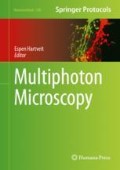Abstract
A central goal of neuroscience is to understand how neural computations are implemented by neural circuits. An excellent model system is the mammalian retina. Besides its important role in visual processing, the retina offers technical advantages for circuit interrogation at the cellular and synaptic levels due to its experimental accessibility and well-defined cell types. Recent development of genetic and molecular tools in mice has made the mouse retina a preferred choice for studying retinal circuitry, since an increasing repertoire of cell types can be specifically labeled by fluorescent proteins. However, measuring the light response of fluorescently tagged retinal neurons is challenging because excitation of fluorophores at visible wavelengths often leads to rapid photopigment bleaching that prevents subsequent recording of light responses from retinal neurons. One way to circumvent this problem is to use multiphoton excitation in the infrared range to visualize fluorescent protein-expressing cells. In this chapter, we describe a detailed protocol for multiphoton-targeted electrophysiological recording from fluorescently labeled retinal neurons while preserving their sensitivity to visual stimulation. This technique also enables live imaging of the three-dimensional morphology of the recorded neurons. With the continued development of cell-specific markers in the mouse retina, this method is expected to be widely used for harnessing the power of genetic and molecular tools in retinal circuit analysis.
Access this chapter
Tax calculation will be finalised at checkout
Purchases are for personal use only
References
Sanes JR, Masland RH (2015) The types of retinal ganglion cells: current status and implications for neuronal classification. Annu Rev Neurosci 38:221–246
Demb JB, Singer JH (2015) Functional circuitry of the retina. Annu Rev Neurosci 1:263–289
Baden T, Berens P, Franke K, Roman Roson M, Bethge M, Euler T (2016) The functional diversity of retinal ganglion cells in the mouse. Nature 529:345–350
Gollisch T, Meister M (2010) Eye smarter than scientists believed: neural computations in circuits of the retina. Neuron 65:150–164
Dhande OS, Stafford BK, Lim J-HA, Huberman AD (2015) Contributions of retinal ganglion cells to subcortical visual processing and behaviors. Annu Rev Neurosci 1:291–328
Vaney DI, Sivyer B, Taylor WR (2012) Direction selectivity in the retina: symmetry and asymmetry in structure and function. Nat Rev Neurosci 13:194
Wei W, Hamby AM, Zhou KL, Feller MB (2011) Development of asymmetric inhibition underlying direction selectivity in the retina. Nature 469:402
Barlow HB, Hill RM, Levick WR (1964) Retinal ganglion cells responding selectively to direction and speed of image motion in the rabbit. J Physiol 173:377–407
Barlow HB, Levick WR (1965) The mechanism of directionally selective units in rabbit’s retina. J Physiol 178:477–504
Simpson JI (1984) The accessory optic system. Annu Rev Neurosci 7:13–41
Cruz-Martín A, El-Danaf RN, Osakada F, Sriram B, Dhande OS, Nguyen PL et al (2014) A dedicated circuit linking direction selective retinal ganglion cells to primary visual cortex. Nature 507:358
Hillier D, Fiscella M, Drinnenberg A, Trenholm S, Rompani SB, Raics Z et al (2017) Causal evidence for retina-dependent and -independent visual motion computations in mouse cortex. Nat Neurosci 20:960–968
Huberman AD, Wei W, Elstrott J, Stafford BK, Feller MB, Barres BA (2009) Genetic identification of an On-Off direction-selective retinal ganglion cell subtype reveals a layer-specific subcortical map of posterior motion. Neuron 62:327–334
Shi X, Barchini J, Ledesma HA, Koren D, Jin Y, Liu X et al (2017) Retinal origin of direction selectivity in the superior colliculus. Nat Neurosci 20:550–558
Zucker CL, Dowling JE (1987) Centrifugal fibres synapse on dopaminergic interplexiform cells in the teleost retina. Nature 330:166–168
van Wyk M, Wassle H, Taylor WR (2009) Receptive field properties of ON- and OFF-ganglion cells in the mouse retina. Vis Neurosci 26:297–308
Zeng H, Madisen L (2012) Mouse transgenic approaches in optogenetics. Prog Brain Res 196:193–213
Yonehara K, Balint K, Noda M, Nagel G, Bamberg E, Roska B (2011) Spatially asymmetric reorganization of inhibition establishes a motion-sensitive circuit. Nature 469:407–410
Euler T, Hausselt SE, Margolis DJ, Breuninger T, Castell X, Detwiler PB et al (2009) Eyecup scope–optical recordings of light stimulus-evoked fluorescence signals in the retina. Pflugers Arch 457:1393–1414
Svoboda K, Yasuda R (2006) Principles of two-photon excitation microscopy and its applications to neuroscience. Neuron 50:823–839
Brainard DH (1997) The Psychophysics Toolbox. Spat Vis 10:433–436
Wei W, Elstrott J, Feller MB (2010) Two-photon targeted recording of GFP-expressing neurons for light responses and live-cell imaging in the mouse retina. Nat Prot 5:1347–1352
Chen Q, Pei Z, Koren D, Wei W (2016) Stimulus-dependent recruitment of lateral inhibition underlies retinal direction selectivity. Elife 5:e21053
Pei Z, Chen Q, Koren D, Giammarinaro B, Ledesma HA, Wei W (2015) Conditional knock-out of vesicular GABA transporter gene from starburst amacrine cells reveals the contributions of multiple synaptic mechanisms underlying direction selectivity in the retina. J Neurosci 35:13219–13232
Author information
Authors and Affiliations
Corresponding author
Editor information
Editors and Affiliations
Rights and permissions
Copyright information
© 2019 Springer Science+Business Media, LLC, part of Springer Nature
About this protocol
Cite this protocol
Chen, Q., Wei, W. (2019). Using Multiphoton Imaging for Targeted Electrophysiological Recording and Live Cell Imaging of Fluorescently Labeled Neurons from Isolated Retinas. In: Hartveit, E. (eds) Multiphoton Microscopy. Neuromethods, vol 148. Humana, New York, NY. https://doi.org/10.1007/978-1-4939-9702-2_2
Download citation
DOI: https://doi.org/10.1007/978-1-4939-9702-2_2
Published:
Publisher Name: Humana, New York, NY
Print ISBN: 978-1-4939-9701-5
Online ISBN: 978-1-4939-9702-2
eBook Packages: Springer Protocols

